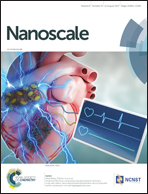Particle size affects the cytosolic delivery of membranotropic peptide-functionalized platinum nanozymes†
Abstract
Delivery of therapeutic agents inside the cytosol, avoiding the confinement in endo–lysosomal compartments and their degradative environment, is one of the key targets of nanomedicine to gain the maximum remedial effects. Current approaches based on cell penetrating peptides (CPPs), despite improving the cellular uptake efficiency of nanocarriers, have shown controversial results in terms of intracellular localization. To elucidate the delivery potential of CPPs, in this work we analyzed the role of the particle size in influencing the ability of a membranotropic peptide, namely gH625, to escape the endo–lysosomal pathway and deliver the particles in the cytosol. To this aim, we carried out a systematic assessment of the cellular uptake and distribution of monodisperse platinum nanoparticles (PtNPs), having different diameters (2.5, 5 and 20 nm) and citrate capping or gH625 peptide functionalization. The presence of gH625 significantly increased the amount of internalized NPs in human cervix epithelioid carcinoma cells, as a function of particle size. However, scanning transmission electron microscopy (STEM) and electron tomography (ET) revealed a prevalent confinement of PtNPs within vesicular structures, regardless of the particle size and surface functionalization. Only in the case of the smallest 2.5 nm particles, the membranotropic peptide was able to partly maintain its functionality, enabling cytosolic delivery of a small fraction of internalized PtNPs, though particle agglomeration in culture medium limited single-particle transport across the cell membrane. Interestingly, membrane crossing by 2.5 nm functionalized-PtNPs seemed to occur by diffusion through the lipid bilayer, with no apparent membrane damage. For larger particle sizes (≥5 nm), their hindrance likely blocked the membranotropic mechanism. Combining the enhanced uptake and partial cytosolic delivery promoted by gH625, we were able to achieve a strong improvement of the antioxidant nanozyme function of 2.5 nm PtNPs, decreasing both the endogenous ROS level and its overproduction following an external oxidative insult.



 Please wait while we load your content...
Please wait while we load your content...